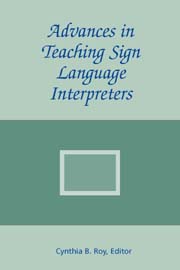Cynthia B. Roy, Editor
Foreword by Franz Pöchhacker
|
View the table of contents. View the list of contributors. Read the foreword. Read the introduction. Read an excerpt. Read a review. |
$63.25s print edition $63.25 e-book |
Interpreter Education, Volume 2
From Interpreting, International Journal of Research and Practice in Interpreting, cont’d.
The next paper deals with how to manage the intercultural processes of turn-taking and turn-yielding in joint meetings of deaf and hearing participants. The chair in such situations is often unacquainted with the requirements for guaranteeing equal participation of the d/Deaf. Mieke van Herreweghe overviews the work of various turn-taking theorists in spoken-language settings, as little has been written on the subject regarding signed languages. There follows a comparison of the differences between spoken and signed conversations, looking at the turn-taking mechanism and pointing out several interesting cultural differences such as the use of a name as an addressee device in spoken language, which is not culturally acceptable in sign language; the Deaf would use pointing signs to the person involved. Another cultural difference is that eye gaze among deaf ‘speakers’ has the very important function of selecting the next to speak, whereas among hearing interlocutors it does not have this function. The author emphasizes that it is the interpreter who must intervene by becoming an active participant in meetings, as not all chairpersons are aware that they must address several cross-cultural differences. Suggestions for real-life simulation and role play in the classroom are offered to build up the students’ metalinguistic awareness of turn-taking in both spoken-language and signed-language meetings.
Particular cases of false friends encountered when interpreting from Swedish Sign Language to Swedish are dealt with by Anna-Lena Nilsson, who understands them in a different sense from their usual meaning. In sign language much of the linguistic message is transferred through non-manual signals such as mouth movements, some of which resemble those used in the pronunciation of spoken Swedish words which, however, should not always be used when translating the signs into Swedish. Interpreters tend to use the spoken mouth movement even when the meaning of a sign might not be captured well by this word and thus impede the understanding of the sign. Nilsson also examines the problem of signs whose Swedish mouth movements resemble Swedish swear words. These mouth movements are acceptable in Swedish Sign Language but often avoided by students. Another form of sign language false friends is connected to cross-cultural register issues, as in greetings. Exercises suggested by the author to overcome these problems include finding synonyms in both languages to improve linguistic correctness and practising greetings in different settings by watching tapes and learning set phrases in both languages.
Cynthia B. Roy is a retired professor in the Department of Interpretation and Translation at Gallaudet University, where she directed the BA program and the PhD program. She is also a nationally certified American Sign Language–English interpreter specializing in community interpreting.
Print Edition: ISBN 978-1-56368-320-6, 6 x 9 casebound, 224 pages, tables, figures, references, index
$63.25s
E-Book: ISBN 978-1-56368-391-6
$63.25
To order by mail, print our Order Form or call:TEL 1-800-621-2736; (773) 568-1550 8 am - 5 pm CST
TTY 1-888-630-9347
FAX 1-800-621-8476; (773) 660-2235
